The Advantech SKY-7223D is a 2U short-depth server that is designed largely for 5G telco use cases. Advantech has designed the SKY Series of low-latency edge servers to fit in areas of limited space and extreme environments, when compared to traditional data centers. Like most rugged telco servers, all the I/O access is through the front including storage, PCIe, and networking, a bit different from the company’s other servers. The server also has hot-swap elements built for easy, quick service in the field.
The Advantech SKY-7223D is a 2U short-depth server that is designed largely for 5G telco use cases. Advantech has designed the SKY Series of low-latency edge servers to fit in areas of limited space and extreme environments, when compared to traditional data centers. Like most rugged telco servers, all the I/O access is through the front including storage, PCIe, and networking, a bit different from the company’s other servers. The server also has hot-swap elements built for easy, quick service in the field.
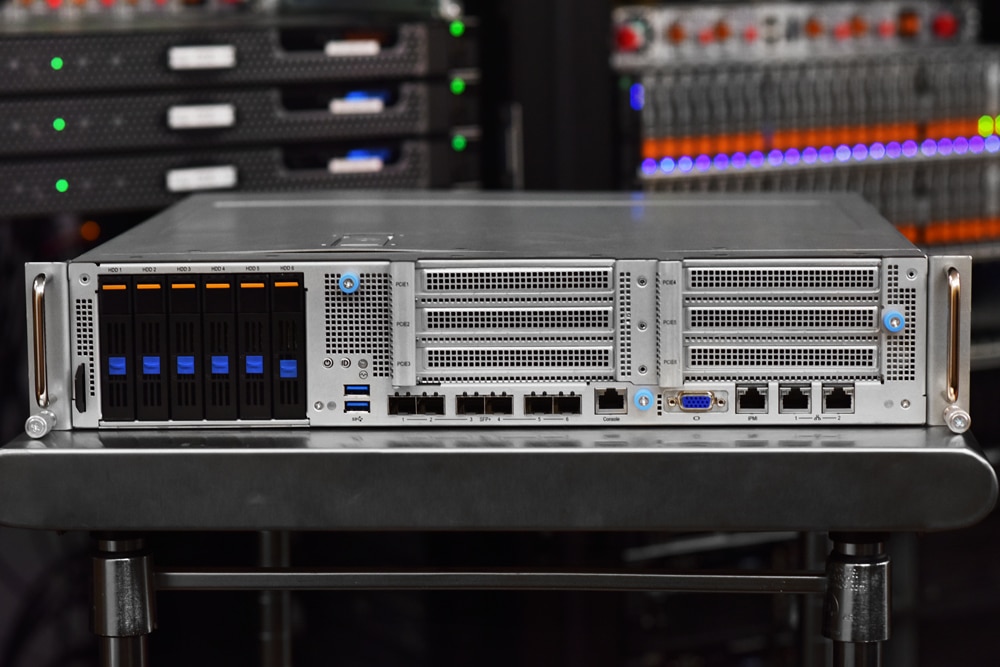
In recent years we have seen an explosion in IoT and edge devices. This can bring a multitude of benefits but at the same time is generating massive amounts of data that needs to be collected and analyzed. Sending this data to the core takes time. By leveraging edge computing servers, like the Advantech SKY-7223D, organizations can be more nimble and react more quickly. This holds true for use cases like real-time analytics, where the ability to run analytics at the edge is key to successful outcomes.
Under the hood, the SKY-7223D is powered 2nd Gen Intel Xeon Scalable processors (dual socket) with Intel QAT and DPDK to improve overall performance. It also features 16 x DDR4 DIMM slots (12 x channels, up to 2933MHz) that surround the CPUs. The server supports six 2.5″ SATA bays or two 2.5″ SATA bays and 4 bays that house 2.5″ U.2 NVMe drives. At just 17″ deep, the server can fit in a variety of rack configurations. These include traditional telco use cases, either near or on a cell tower for instance. The server also does well in industrial and other use cases where its compact body and increased environmental tolerances are useful.
Advantech can make their edge computing servers highly customizable to fit users’ specific needs. For our review, we have more of an off-the-shelf model to get an idea of how it runs.
Advantech SKY-7223D Specifications
| System P/N | SKY-7223D2A-06A1R | |
| Form Factor | 2U | |
| Processor | Processor Type | 2nd Gen. Intel Xeon Scalable Processors (Cascade Lake/Skylake) |
| Max TDP | 165W | |
| Number of Processors | 2 | |
| Cores | up to 26 cores | |
| Chipset | Intel C626 (QAT Support) | |
| Memory | Memory Capacity | 16x DDR4 Slots, 12 channels, up to 2933MHz |
| Memory Type | 2933/2666/2400/2133MHz ECC DDR4 | |
| Storage | 2.5″ HDD/SSD | 2 x SATA plus 4 x U.2 NVMe |
| Expansion Slots | [SKU1] 4 x PCIe Gen3x16 (FHFL)[SKU2] 2 x PCIe Gen3x16 (FHFL) plus 4 x PCIe Gen3x8 (FHHL) [SKU3] 2 x Double Width PCIe Gen3x16 (FHFL) plus 2 x PCIe G |
|
| Input/Output | Front I/O | 2 x USB3.0 6 x 10G SFP+ 1 x RJ45 Console 1 x VGA 2 x GbE RJ45 plus 1 x GbE RJ45 management2 x RS422 |
| Rear I/O | NA | |
| Power Supply | Power Rating | CRPS 1200W |
| Input | AC 100~240 V @ 50~60Hz. Full range | |
| Cooling | 4 x 8038 fan, 4 x hot-swap 8056 fan by option | |
| TPM | TPM2.0 by module (optional) | |
| Time Synchronization | GPS, 1588 v2, and cascading (1pps + TOD) | |
| System Management | Industry-standard BMC, IPMI v2.0 / Redfish compliant, with a web interface and iKVM |
Advantech SKY-7223D Design and build
The Advantech SKY-7223D is a rugged-looking server that features a nice, compact overall design. As this is a telco server, the layout of the rack and the server itself is a bit different compared to the traditional ones you mostly see. For example, telco server environments often use two-post racks (compared to the usual 4-post racks), which comprise of just two vertical posts and are placed (or sometimes bolted) on the floor. They are purpose-built to better handle certain IT equipment that telco environments require.
The openness of telco racks allows for much easier access to the equipment. It also provides a better cooling design (as they are not enclosed like 4-post racks) for better airflow circulation and exhausting hot air. They are also easier to disassemble and move around the server room, are space-efficient, and are ideal for applications where a locked cabinet isn’t required.
The other unique feature of telco servers is that nearly all connectivity is located on the front. This is due to the nature of telco environments, as IT staff often need access to the ports and connectivity while working with the server. A nice side benefit is staff generally won’t have to subject themselves to “hot aisles” with these types of servers.
This is the case with the Advantech SKY-7223D. Running along the bottom are the six 10G SFP+ and two GbE RJ45 ports, an RJ45 management port, the serial port, and dual USB 3.0 ports. Above all the connectivity are the six PCIe expansion slots, which can be configured in three different ways: four PCIe Gen3 x16 (FHFL), two PCIe Gen3 x16 (FHFL) and four PCIe Gen3 x8 (FHHL), or two double-width PCIe Gen3 x16 drives (FHFL) and two PCIe Gen3x8 (FHHL) drives.
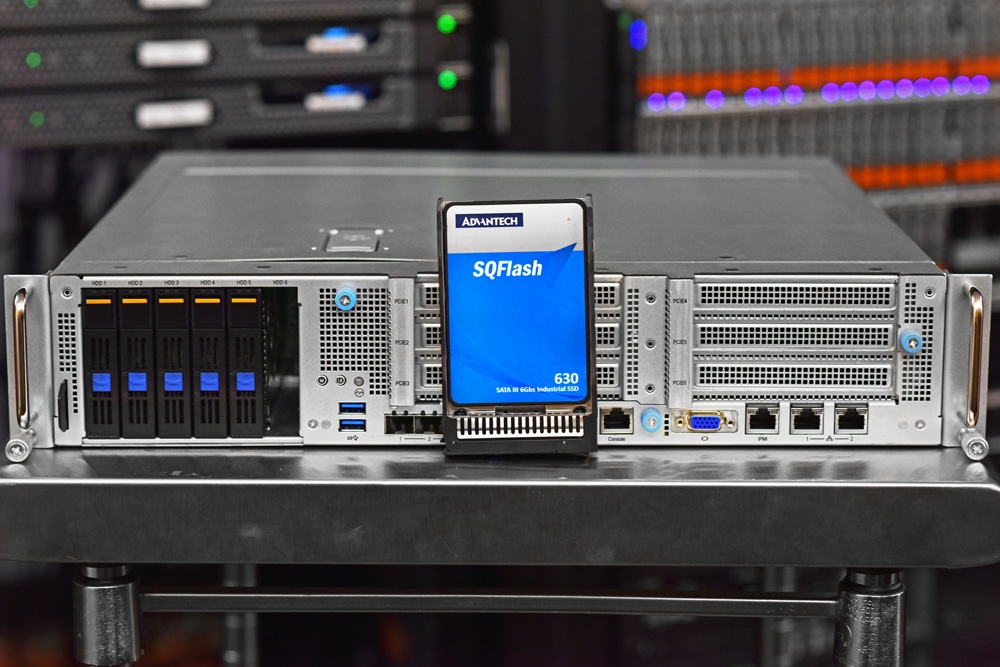
On the left of the front panel are the drive trays, which house six 2.5″ drives. These can be configured in SATA only, or a mixed SATA plus NVMe combination. Advantech also manufactures their own SSDs; they included both a SATA and NVMe SKU with this build. As you can see, there is also ample ventilation on the front panel so the fans can do their job effectively and exhaust heat from the server.
Turning the server around, you will see the four large 8056 fan modules, which can be easily hot-swapped out by simply unfastening the screws and pulling the individual handle out. To the right are the 1200W CRPS power supplies, which also can be easily pulled out and replaced as needed.
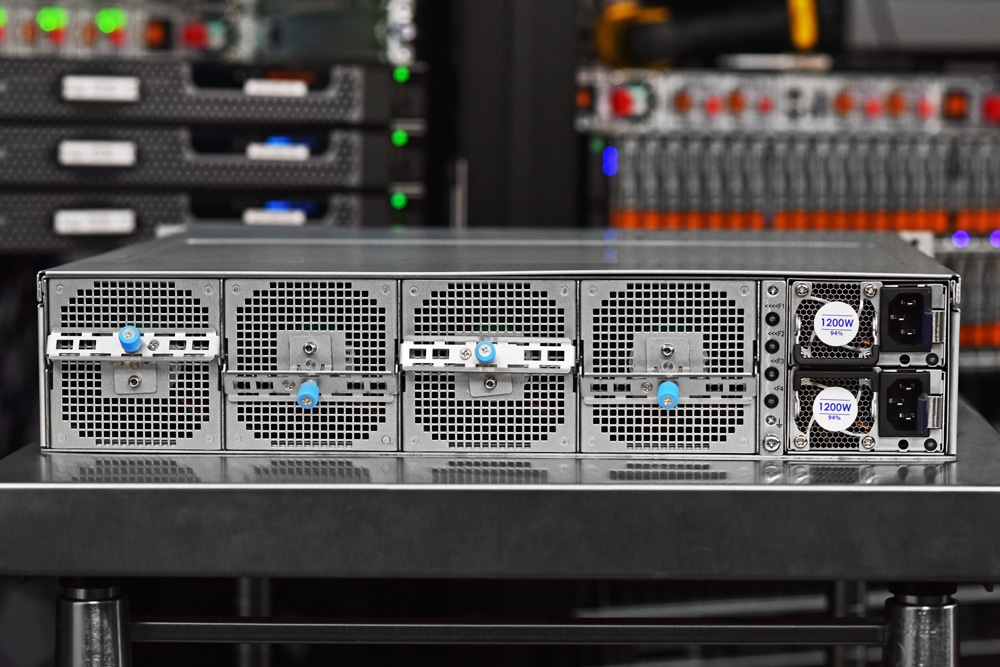
Opening up the cover, we can easily see the two CPUs and surrounding DIMMs. And even though the server is short by data center standards, there’s plenty of room for PCIe cards, including GPUs, in this box.
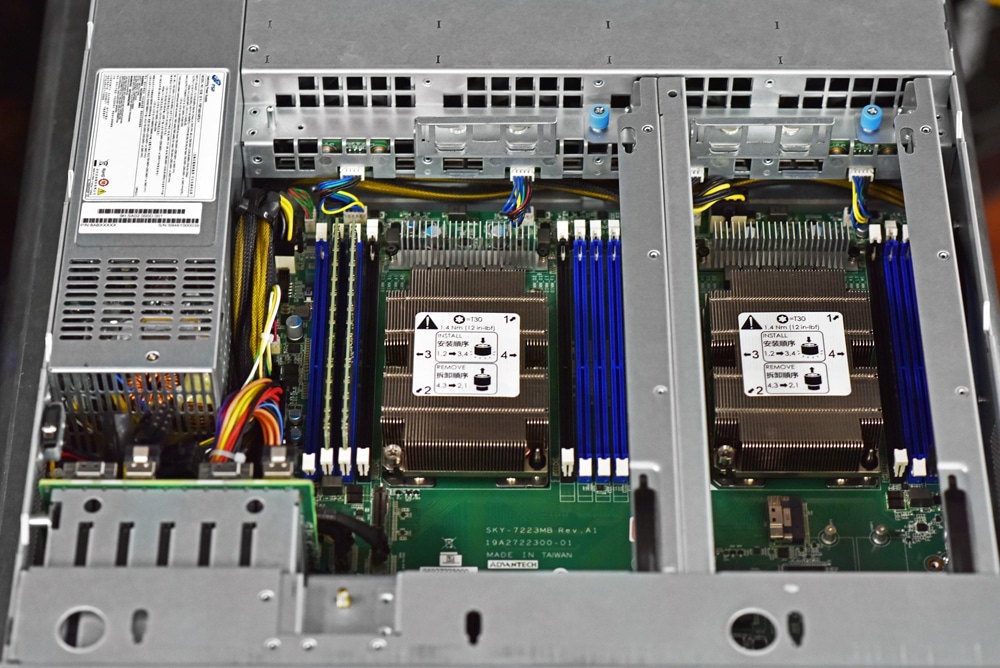
Below we can see storage connectivity from the motherboard that supports SATA, SAS, and NVMe.
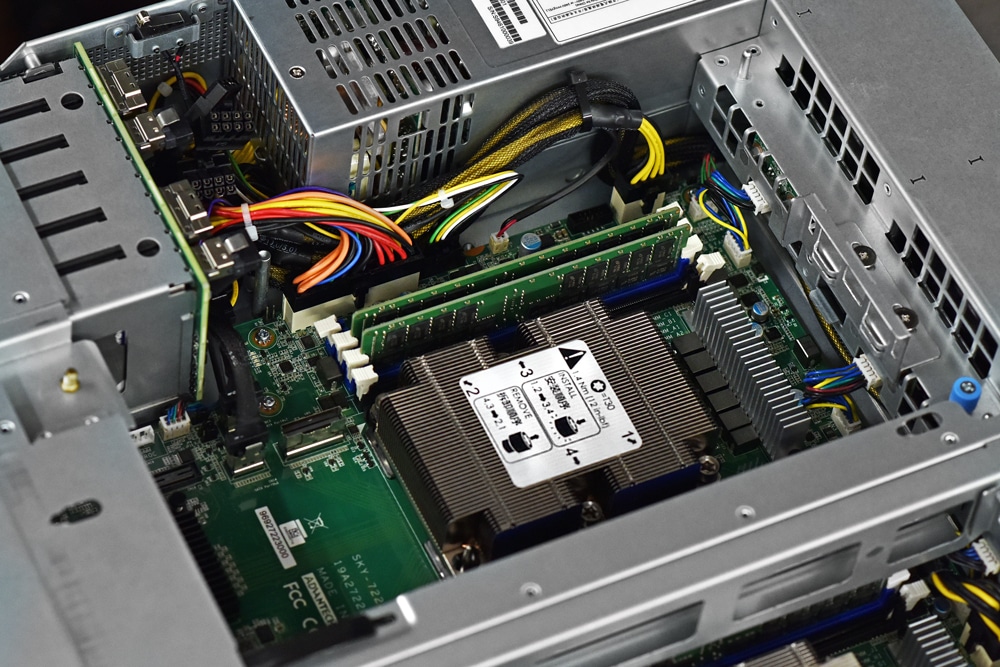
Management
The Advantech SKY-7223D’s management is nothing fancy, just a simple layout that works. To take a gander at the hardware, we click on advanced inventory. Through the sub-tab of CPU, we can see the two Intel Xeon Gold 6230N CPUs.
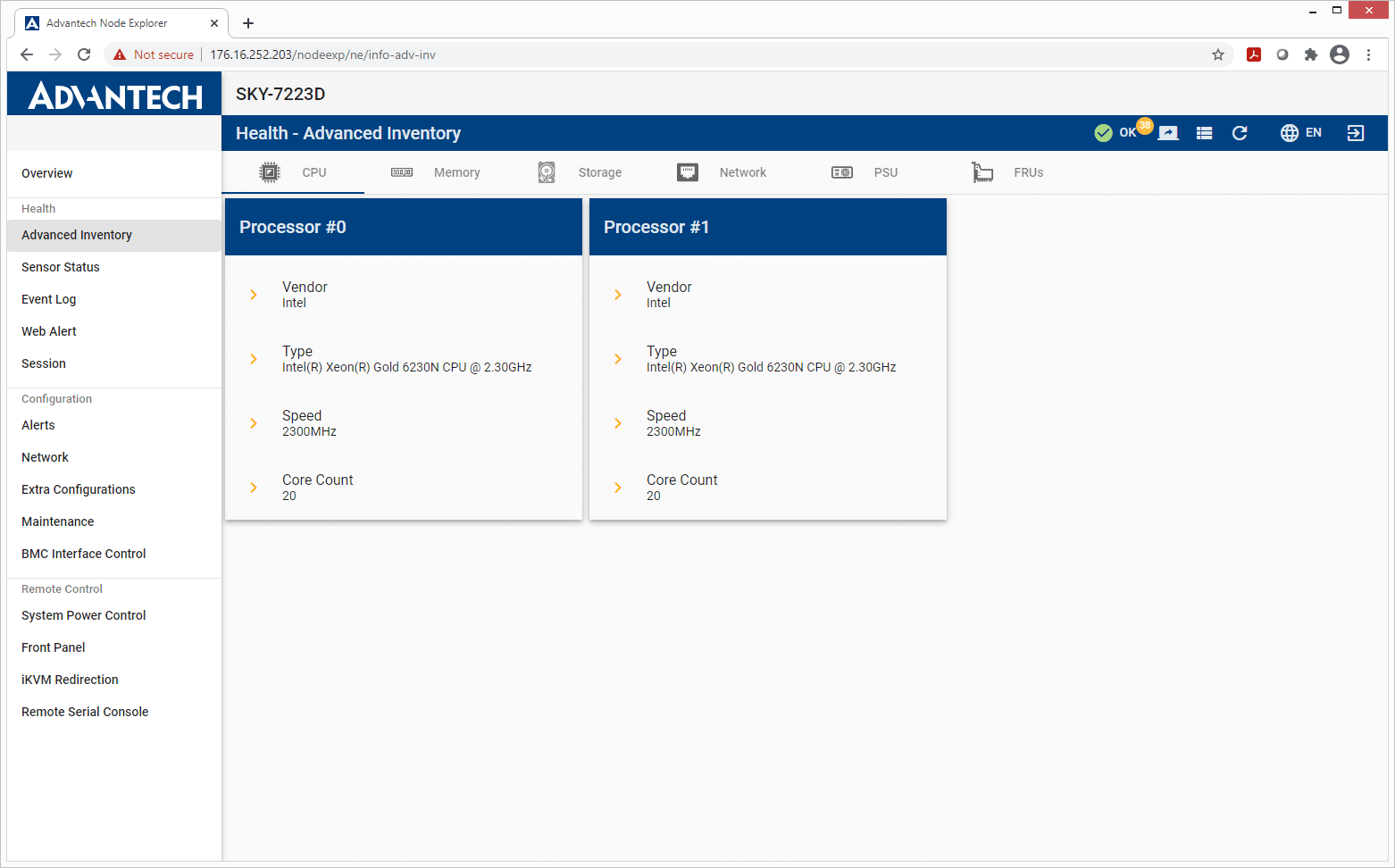
Through this same main tab, we can check on storage and see the connected NVMe storage drives.
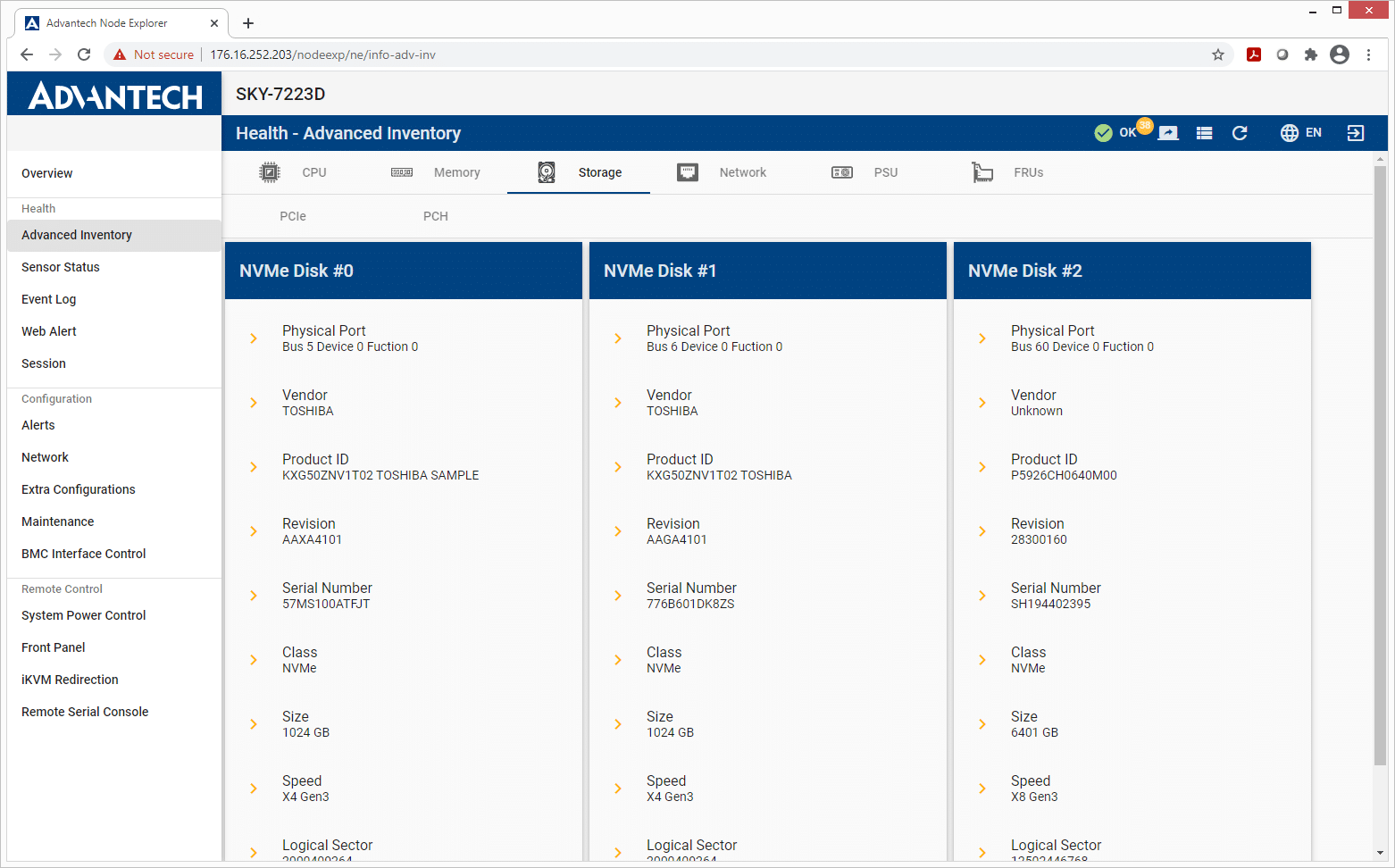
We can also remote in through the HTML5 interface and attach storage for easy software installation.
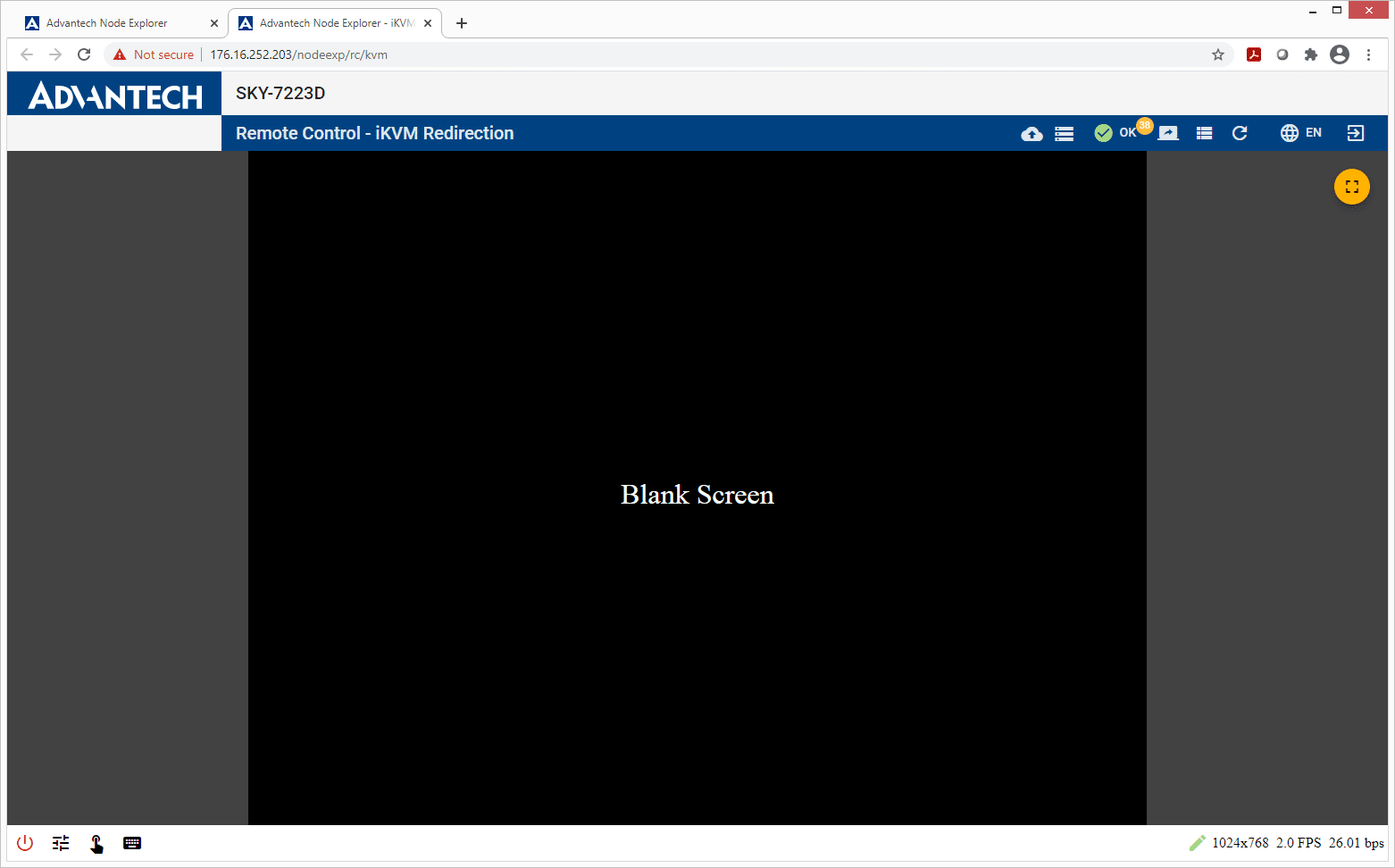
Advantech SKY-7223D Performance
Performance Configuration
- 2 x Intel Xeon Gold 6230N
- 4 x 32GB DDR4
- CentOS 8
- 2 x 1TB Toshiba XG5 M.2 NVMe SSDs
- 1 x 6.4TB Memblaze 926
While storage is very flexible inside the Advantech SKY-7223D chassis, we tested it with a Memblaze 926 enterprise SSD as well as two Toshiba XG5 SSDs.
VDBench Workload Analysis
When it comes to benchmarking storage arrays, application testing is best, and synthetic testing comes in second place. While not a perfect representation of actual workloads, synthetic tests do help to baseline storage devices with a repeatability factor that makes it easy to do apples-to-apples comparison between competing solutions.
These workloads offer a range of different testing profiles ranging from “four corners” tests, common database transfer size tests, as well as trace captures from different VDI environments. All of these tests leverage the common vdBench workload generator, with a scripting engine to automate and capture results over a large compute testing cluster. This allows us to repeat the same workloads across a wide range of storage devices, including flash arrays and individual storage devices.
Profiles:
- 4K Random Read: 100% Read, 128 threads, 0-120% iorate
- 4K Random Write: 100% Write, 64 threads, 0-120% iorate
- 64K Sequential Read: 100% Read, 16 threads, 0-120% iorate
- 64K Sequential Write: 100% Write, 8 threads, 0-120% iorate
- Synthetic Database: SQL and Oracle
- VDI Full Clone and Linked Clone Traces
With random 4K read, the SKY-7223D peaked at 798,821 IOPS with a latency of 159.1µs using the NVMe Edge card while hitting 618,966 IOPS at 360.2µs using two NVMe M.2 drives.
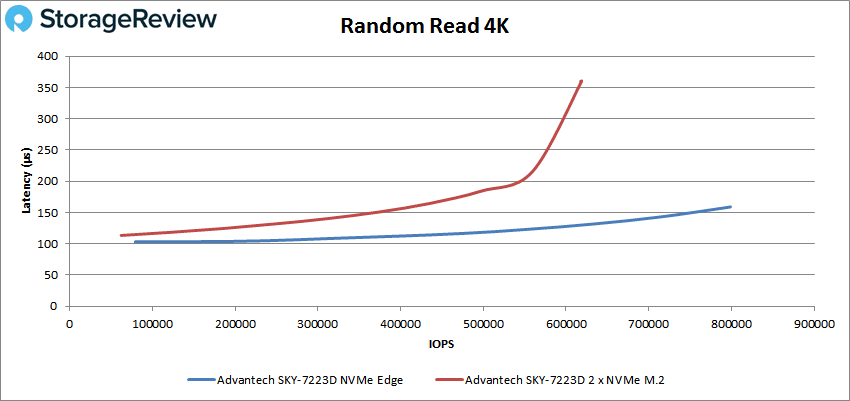
Random 4K write saw the SKY-7223D peaking at around 559,435 IOPS with a latency of just over 200µs with the edge card, while reaching 192,223 IOPS at 1,023µs using dual NVMe M.2 drives.
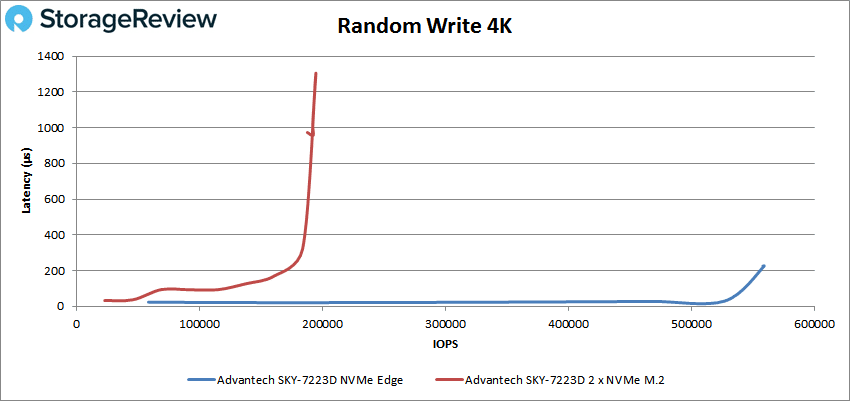
Next up is sequential workloads where we looked at 64k performance. For reads, the SKY-7223D server peaked at 83,534 IOPS (or 5.22GB/s) at a latency of 382.3µs (edge) and 43,468 IOPS (or 2.72GB/s) at 1,467µs (2 x NVMe).
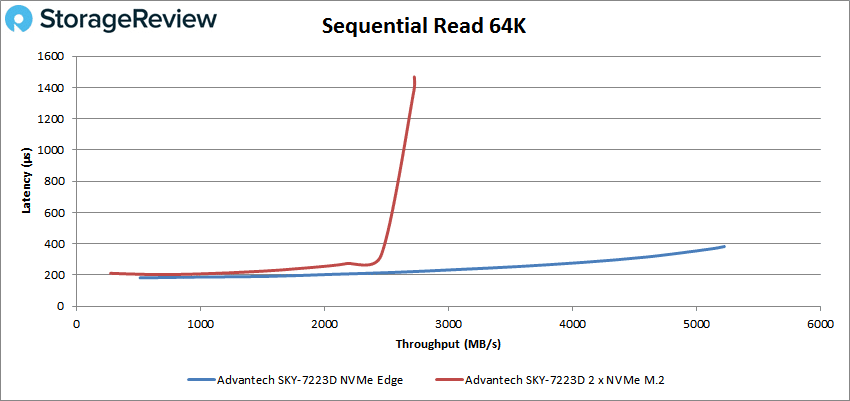
In writes, we saw a peak of 42,847 IOPS (2.68GB/s) at 188.2µs (edge), and 16,156 IOPS (1.0GB/s) at 1,983µs (2 x NVMe). Both had slight performance dips at the end.
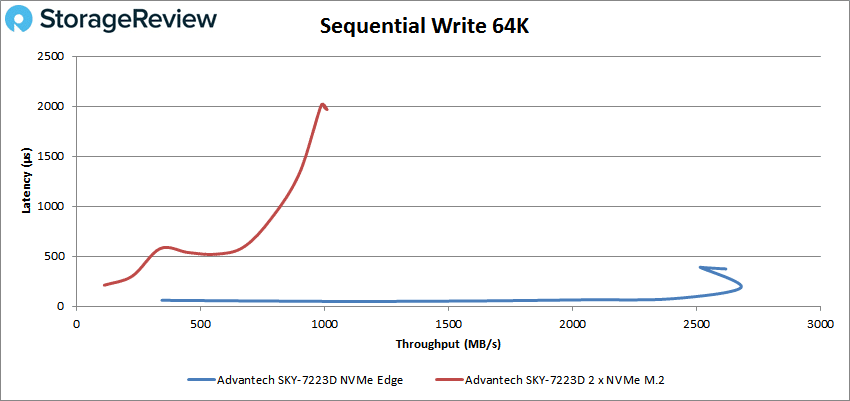
Our next set of tests are our SQL workloads: SQL, SQL 90-10, and SQL 80-20. Starting with SQL, the SKY-7223D saw peaks of 237,973 IOPS at a latency of 153.8µs (Edge), and 253,343 IOPS at 241µs (2 x NVMe).
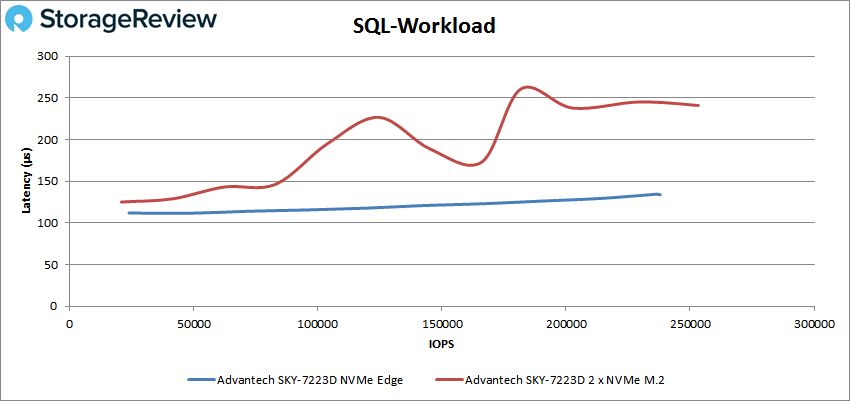
For SQL 90-10, the SKY-7223D server peaked at 249,908 IOPS at 127.4µs for latency (Edge) and 199,198 IOPS and 284.7µs (2 x NVMe) before taking a very slight dip in performance at the end.
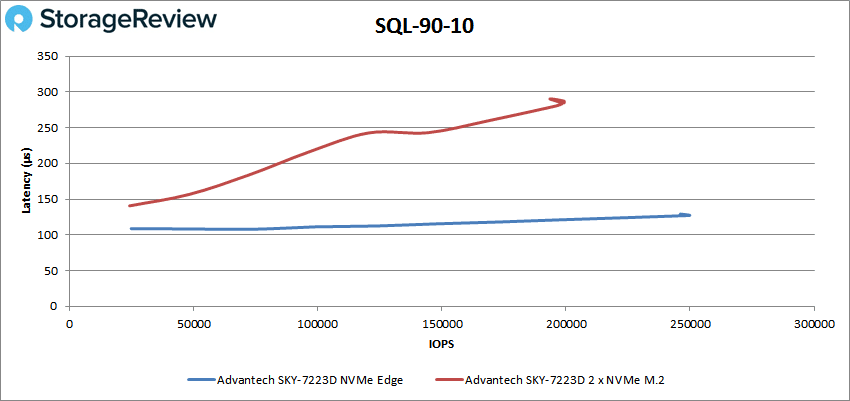
Moving on to SQL 80-20, the SKY-7223D server saw peak performances of 250,327 IOPS with a latency of 127.µs (Edge), and 191,890 IOPS at 322.6µs in latency (2 x NVMe).
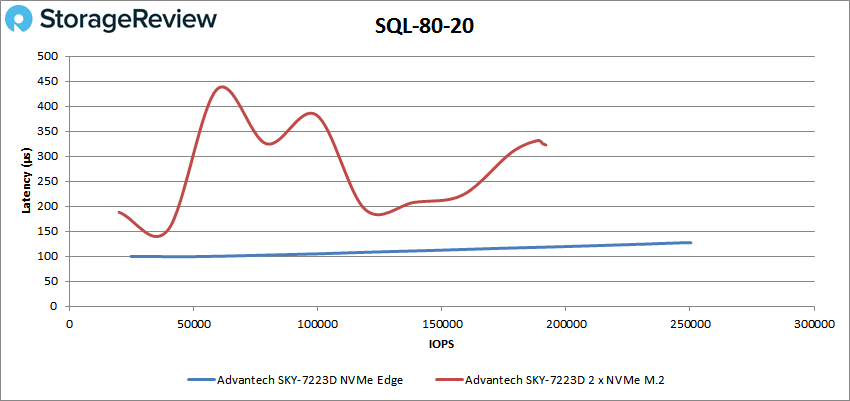
Next up are our Oracle workloads: Oracle, Oracle 90-10, and Oracle 80-20. Starting with Oracle, the SKY-7223D recorded peak performances at 267,511 IOPS with a latency of 132.6µs (Edge), and 165,823 IOPS at 385.5µs (2 x NVMe).
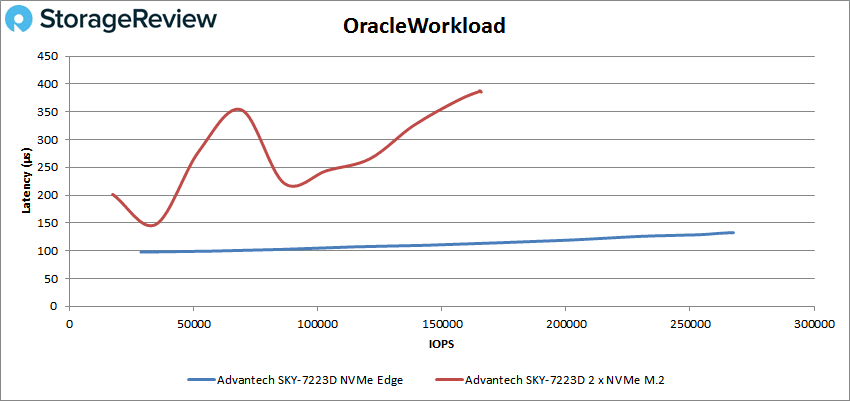
With Oracle 90-10, the SKY-7223D peaked at 189,327 IOPS at a latency of 115.2µs (Edge), and 181,216 IOPS at 229.7µs (2 x NVMe).
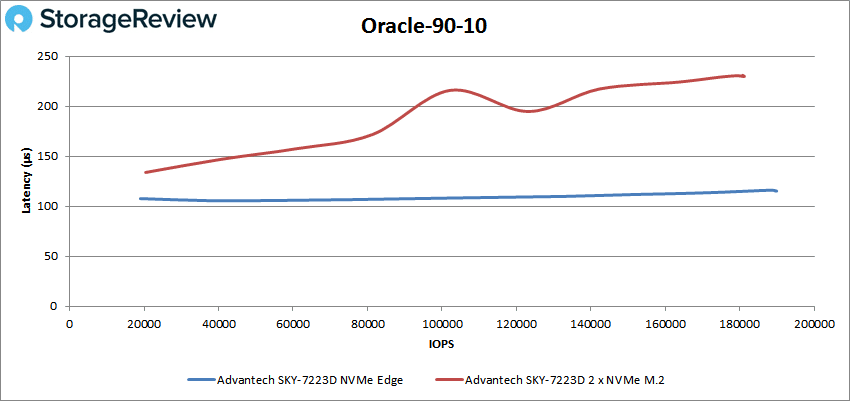
Oracle 80-20 gave the server peak performances of 195,642 IOPS at a latency of 111.6µs, and 164,155 IOPS at 266.9µs (both taking a small dip in IOPS at the end of the test).
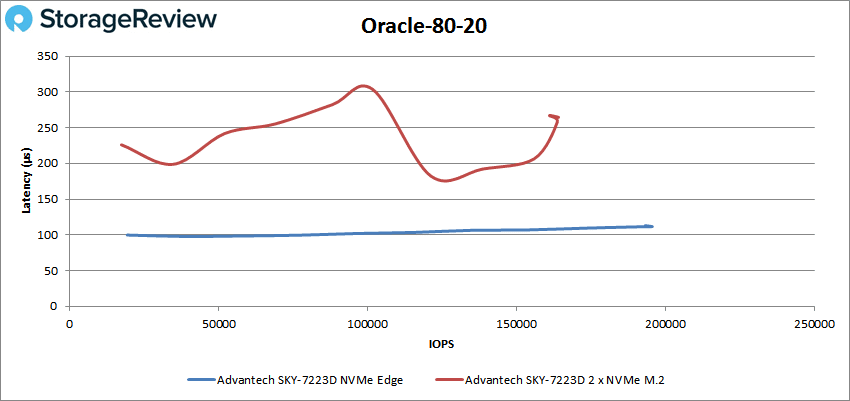
Next, we switched over to our VDI clone test, Full and Linked. For VDI Full Clone (FC) Boot, the SKY-7223D hit peaks of 209,479 IOPS with a latency of 165.1µs (Edge), and 152,367 IOPS (2 x NVMe), which hovered around the 400 µs mark.
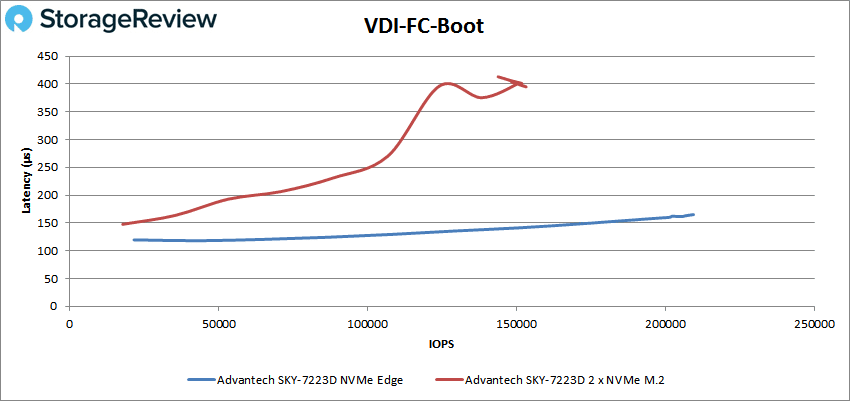
For VDI FC Initial Login, we saw peak performances at the 160K and 200µs marks with the edge card, while the two NVMe M.2 drives showed a peak of 51,375 IOPS at 1,132.2µs.
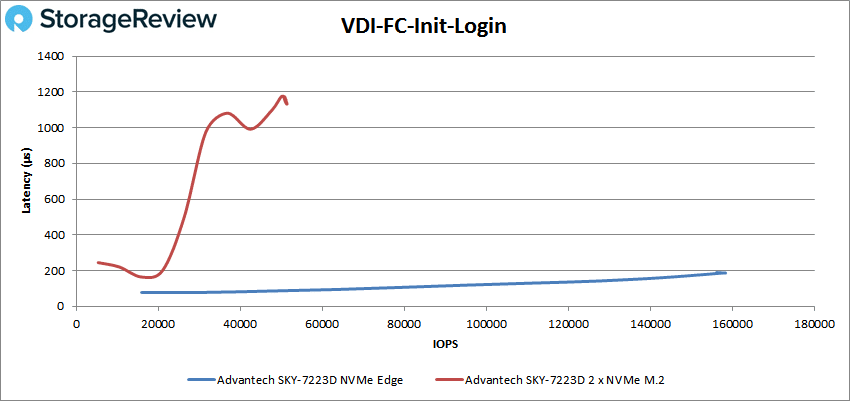
VDI FC Monday Login gave peaks of 103,812 IOPS and latency of 151.9µs (Edge), and 44,856 IOPS at 701.6µs in latency (2 x NVMe).
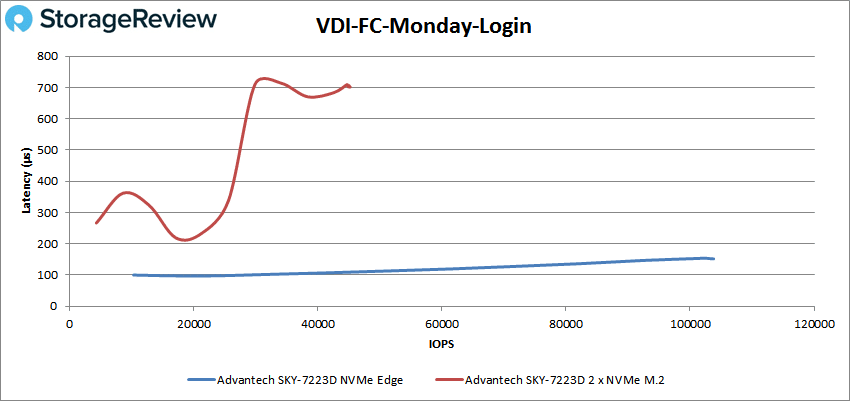
Switching to VDI Linked Clone (LC) Boot, the SKY-7223D showed peaks of 95,991 IOPS and a latency of 166µs (Edge), and 94,900 IOPS at 327.1µs (2 x NVMe), both with slight dips in performance at the very end.
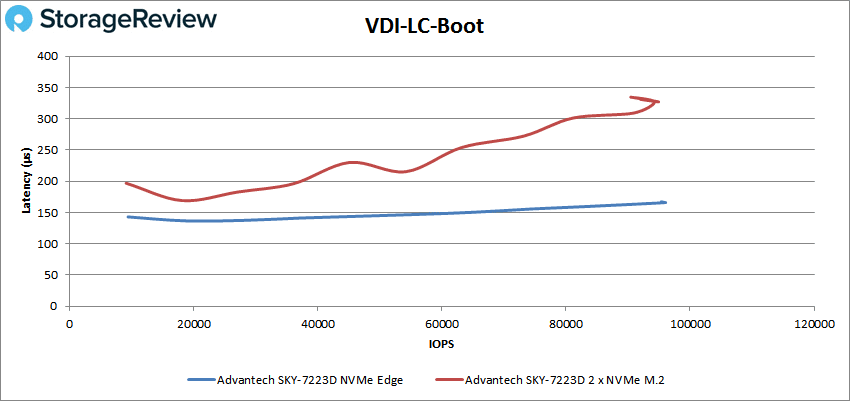
For VDI LC Initial Login, the server peaked at a very stable 55,889 IOPS with a latency of 140.4µs via Edge, and 26,581 IOPS at around 600µs with 2 x NVMe drives.
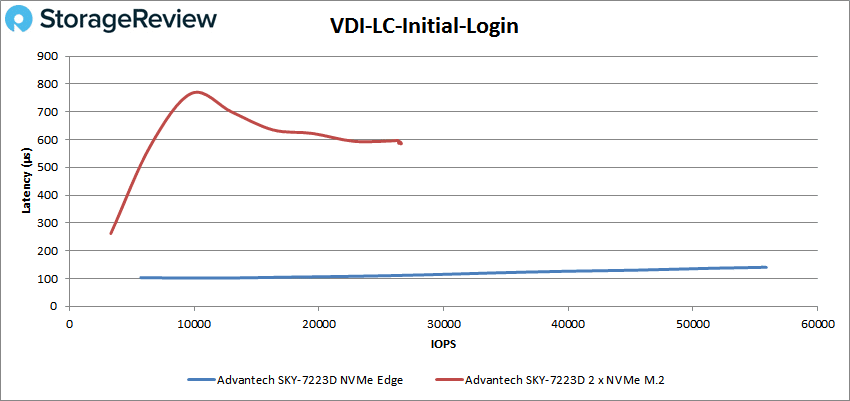
Finally, VDI LC Monday Login had peaks of 80,237 IOPS with a latency of 197.7µs (Edge), and 36,103 IOPS at 866.4µs (2 x NVMe).
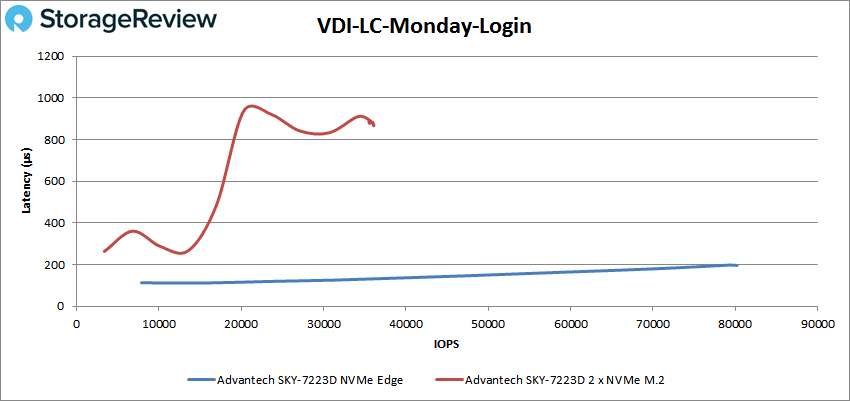
Conclusion
The Advantech SKY-7223D is a 17″ deep, 2U, dual-socket, 5G telco edge server that is made for edge deployments. Being a telco server, the device has the IO on the front, including networking and PCIe expansion, which are normally on the back of the server. The server comes with up to two 2nd gen Intel Xeon processors, 16 DDR4 DIMM slots, and six 2.5” drive bays supporting SATA, SAS, and NVMe. The PCIe slots add the option of more storage, faster networking, or GPUs for specific use cases at the edge such as AI. To top it all off, the company can customize the server, tailoring it to users’ needs.
In our testing, we leveraged two M.2 client SSDs inside as well as a PCIe NVMe SSD installed inside. This was to show the various storage possibilities inside the server, which will really come down to how it deployed in its production setting. Advantech allows for many storage configurations inside the SKY-7223D, through the use of traditional 2.5″ media to M.2 NVMe SSDs inside or making use of the PCIe slots themselves.
For performance, we ran our VDBench Workload Analysis and we used two Memblaze 926 egde card SSDs and two Toshiba XG5 M.2 SSDs. For the edge card we saw highlights of 799K IOPS in 4K read, 559K IOPS in 4K write, 5.2GB/s in 64K read, and 2.7GB/s in 64K write. In SQL we saw peaks of 238K IOPS, 250K IOPS in SQL 90-10, and 250K IOPS in SQL 80-20. For Oracle we saw 268K IOPS, 189K IOPS in Oracle 90-10, and 196K IOPS in Oracle 80-20. In VDI FC we saw 209K IOPS in boot, 160K IOPS in initial login, and 104K IOPS in Monday login. For VDI LC peaks were roughly 96K IOPS in boot, 56K IOPS in initial login, and 80K IOPS in Monday login.
Switching over to the M.2s, we saw highlights of 619K IOPS in 4K read, 192K IOPS in 4K write, 2.7GB/s in 64K read, and 1GB/s in 64K write. In SQL we saw peaks of 253K IOPS, 199K IOPS in SQL 90-10, and 192K IOPS in SQL 80-20. For Oracle we saw 166K IOPS, 181K IOPS in Oracle 90-10, and 164K IOPS in Oracle 80-20. In VDI FC we saw 152K IOPS in boot, 52K IOPS in initial login, and 45K IOPS in Monday login. For VDI LC the server gave us peaks roughly 95K IOPS in boot, 27K IOPS in initial login, and 36K IOPS in Monday login.
Overall there is a lot of potential for this platform out in the wild, no matter if it’s inside the data center or somewhere much more remote. The short depth gives it a lot of deployment opportunities, without sacrificing support for features like GPUs, which are increasingly in-demand for real-time analytics workflows at the edge. The server can also easily be tuned for storage or I/O heavy workloads. Lastly, Advantech will customize the platform for those who have a more specific requirement. While this is primarily targeted for telco use cases, there are surely industrial and others that will benefit from the SKY-7223D’s flexibility and sturdy build.
Advantech SKY-7223D Product Page
Advantech SKY-7223D Data Sheet
Engage with StorageReview
Newsletter | YouTube | Podcast iTunes/Spotify | Instagram | Twitter | Facebook | RSS Feed
